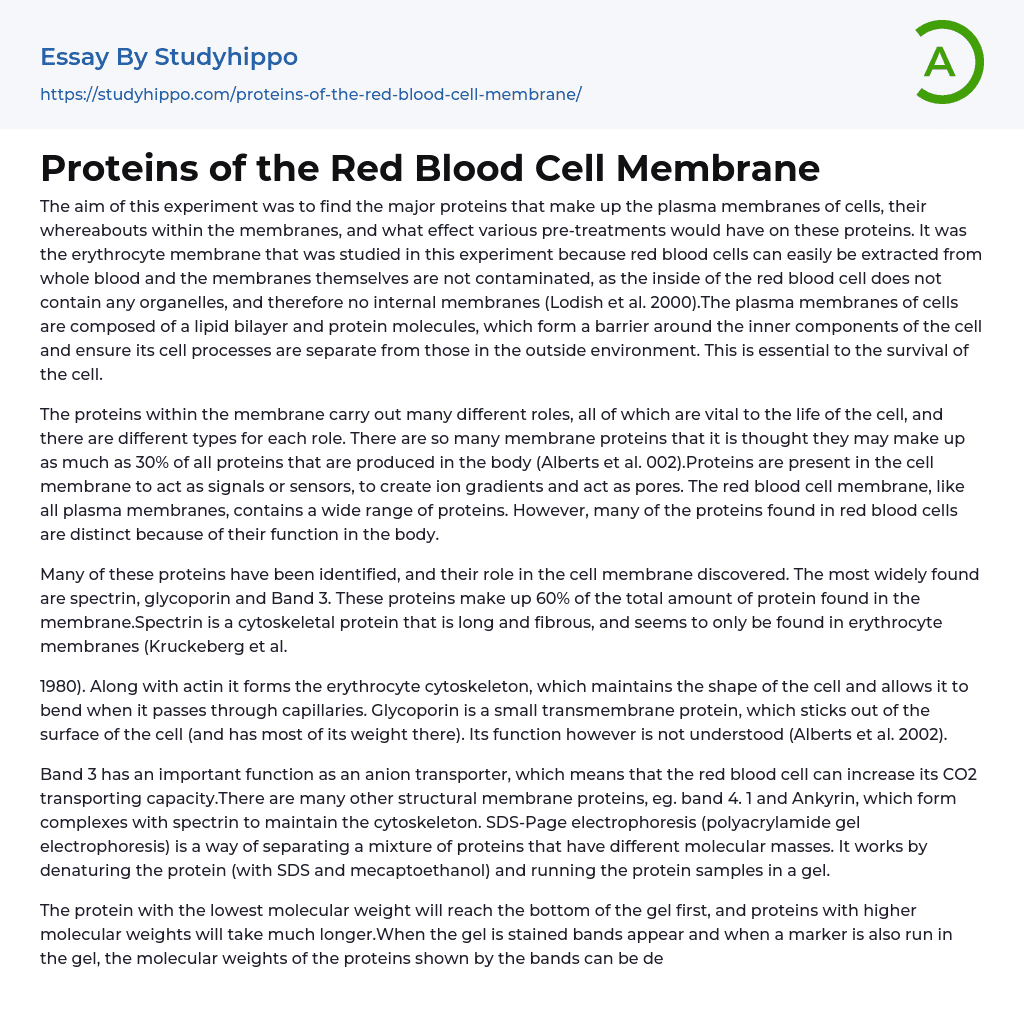The aim of this experiment was to find the major proteins that make up the plasma membranes of cells, their whereabouts within the membranes, and what effect various pre-treatments would have on these proteins. It was the erythrocyte membrane that was studied in this experiment because red blood cells can easily be extracted from whole blood and the membranes themselves are not contaminated, as the inside of the red blood cell does not contain any organelles, and therefore no internal membranes (Lodish et al. 2000).The plasma membranes of cells are composed of a lipid bilayer and protein molecules, which form a barrier around the inner components of the cell and ensure its cell processes are separate from those in the outside environment. This is essential to the survival of the cell.
T
...he proteins within the membrane carry out many different roles, all of which are vital to the life of the cell, and there are different types for each role. There are so many membrane proteins that it is thought they may make up as much as 30% of all proteins that are produced in the body (Alberts et al. 002).Proteins are present in the cell membrane to act as signals or sensors, to create ion gradients and act as pores. The red blood cell membrane, like all plasma membranes, contains a wide range of proteins. However, many of the proteins found in red blood cells are distinct because of their function in the body.
Many of these proteins have been identified, and their role in the cell membrane discovered. The most widely found are spectrin, glycoporin and Band 3. These proteins make up 60
of the total amount of protein found in the membrane.Spectrin is a cytoskeletal protein that is long and fibrous, and seems to only be found in erythrocyte membranes (Kruckeberg et al.
1980). Along with actin it forms the erythrocyte cytoskeleton, which maintains the shape of the cell and allows it to bend when it passes through capillaries. Glycoporin is a small transmembrane protein, which sticks out of the surface of the cell (and has most of its weight there). Its function however is not understood (Alberts et al. 2002).
Band 3 has an important function as an anion transporter, which means that the red blood cell can increase its CO2 transporting capacity.There are many other structural membrane proteins, eg. band 4. 1 and Ankyrin, which form complexes with spectrin to maintain the cytoskeleton. SDS-Page electrophoresis (polyacrylamide gel electrophoresis) is a way of separating a mixture of proteins that have different molecular masses. It works by denaturing the protein (with SDS and mecaptoethanol) and running the protein samples in a gel.
The protein with the lowest molecular weight will reach the bottom of the gel first, and proteins with higher molecular weights will take much longer.When the gel is stained bands appear and when a marker is also run in the gel, the molecular weights of the proteins shown by the bands can be determined. It would be expected that many different bands would be present on the gel, especially spectrin, glycoporin and Band 3, since these are major proteins within the membrane. The acetylcholinesterase assay was used to determine the amount of activity of the enzyme acetylcholinesterase (a small amount of which is found in
the erythrocyte membrane) after the membrane had been pre-treated, and determine the whereabouts of the enzyme within the membrane.
The enzyme catalyses the reaction shown below: Acetylcholine Acetate +Choline The pre-treatments were neostigmine (an inhibitor of the enzyme) and papain (a cysteine proteinase), and both of these treatments would be expected to inhibit the enzyme, preventing it from working. Both of these pre-treatments can only act on the surface of the cell membrane, so any proteins on the cytosolic side of the membrane should not be affected.The supernatant samples should show no enzyme activity, because the enzyme is contained within the membrane. The activity of the enzyme was measured using a spectrophotometer and adding acetylthiocholine to the pre-treated samples. Acetylcholinesterase was shown to be working when the yellow colour of thiol was produced in the solution, meaning acetylthiocholine had been split into its component parts.
From the amount of absorbance per minute the activity of the enzyme in each sample could be calculated.
- Action Potential essays
- Blood essays
- Body essays
- Brain essays
- Childbirth essays
- Eye essays
- Glucose essays
- Heart essays
- Human Physiology essays
- Immune System essays
- Kidney essays
- Muscle essays
- Nervous System essays
- Neuron essays
- Poison essays
- Puberty essays
- Sense essays
- Skeleton essays
- Skin essays
- Bacteria essays
- Biotechnology essays
- Breeding essays
- Cell essays
- Cell Membrane essays
- Cystic Fibrosis essays
- Enzyme essays
- Human essays
- Microbiology essays
- Natural Selection essays
- Photosynthesis essays
- Plant essays
- Protein essays
- Stem Cell essays
- Viruses essays




